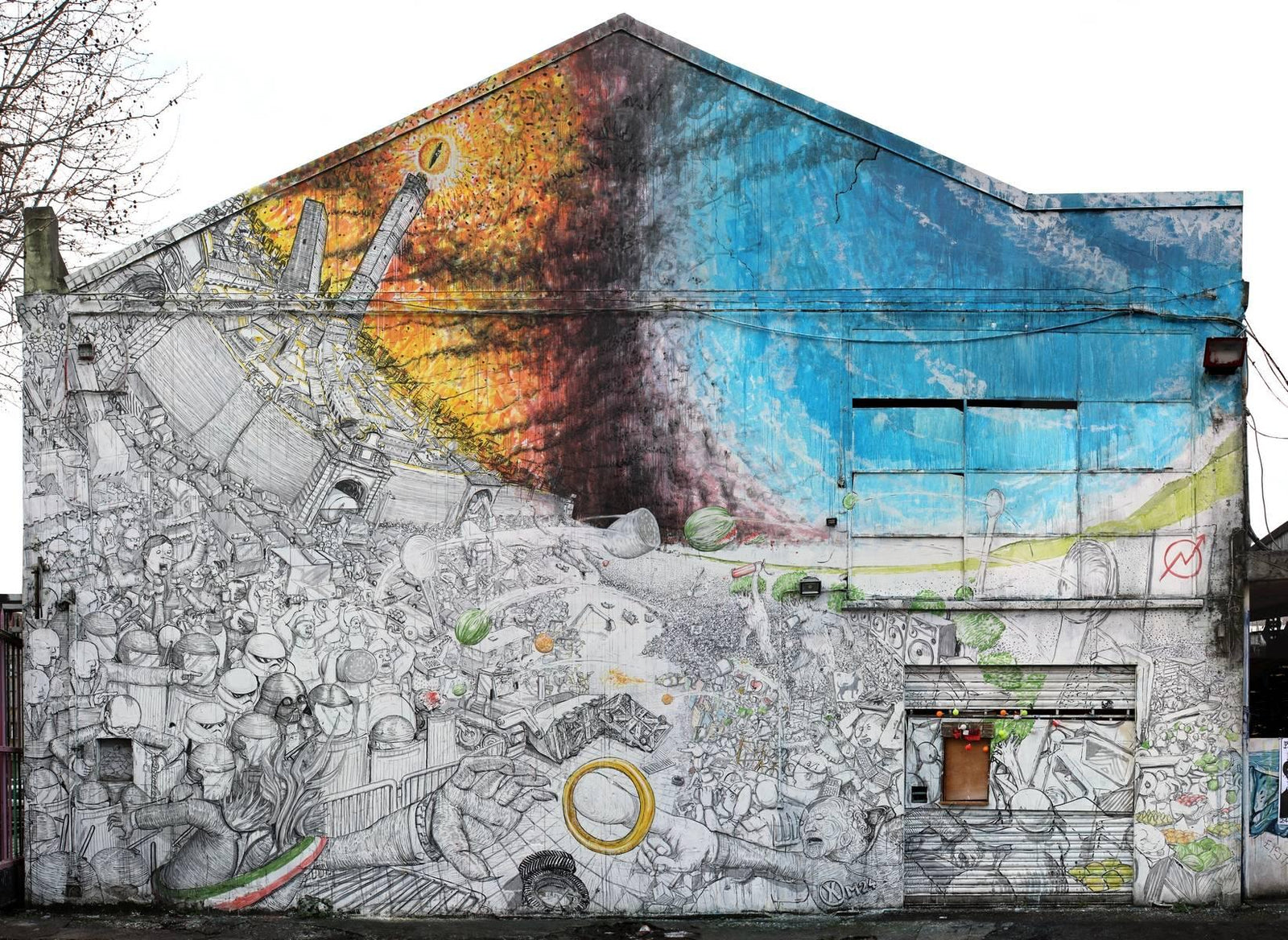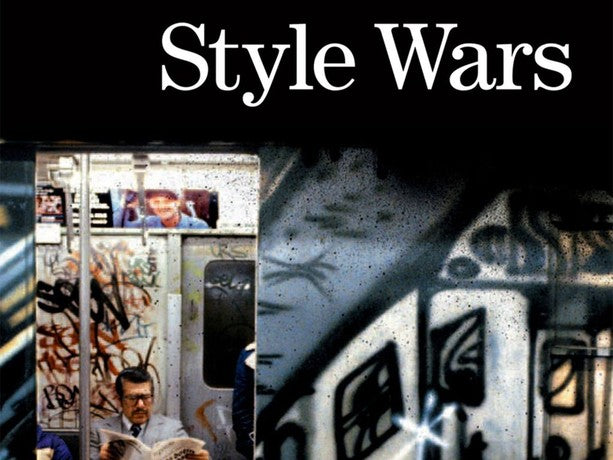Though he’s been described by Juxtapoz as one of the world’s “most famed, elusive, and renegade muralists,” who has “returned the art form to its social conscious and political roots,” Italian street art legend BLU recently made headlines not for any new works he’s created, but for those he’s destroyed.

Still shrouded in mystery, his true name and identity unknown, BLU spent 2016 canvassing Bologna in an effort todestroy every piece of mural art he’d created in the city in the previous 20 years. BLU began this project in protest of “Banksy & Co,” a gallery opening at Bologna’s Palazzo Peopli, which included works of street art that had been removed from their original locations.
“After having denounced and criminalized graffiti as vandalism,” BLU said in a rare public statement, “after having oppressed the youth culture that created them, after having evacuated the places which functioned as laboratories for those artists, now Bologna’s powers-that-be pose as the saviors of street art.” Outraged by what he saw as the gallery’s disrespect and hypocrisy, BLU decided that rather than have his work co-opted, he would erase it himself, the artist concluding: “The only thing left to do is making these paintings disappear, to snatch them from those claws, to make hoarding impossible.”

While many debate the value of and reasoning behind BLU’s actions (is this a case of self-absorption or selflessness, an example of artistic integrity or naivete?), what’s undebatable is the end result. All that remains of these murals is a series of flat white silhouettes -- swathes of blankness reminding us of what once was.
Perhaps they are also a reminder of our need to appreciate any new works by BLU. After all, who can say when the artist -- ever-committed to creating on his own terms -- might decide it’s time for them to vanish?

Whitewashed: What (Little) We Know About BLU
Anyone hoping to learn about BLU via a quick Google search is sure to be disappointed. Even the most basic details of his early life and identity are difficult to pin down, but we do know that BLU was born in Italy and has been a part of the Italian graffiti art scene since 1999, with Bologna functioning as his home base. He rose to prominence through his bold and large-scale collaborations with street art contemporaries like Dem, Sweza, Run, andEricailacane, wielding spray paint, house paint, and rollers attached to long telescopic sticks.

Driven by wanderlust and a seemingly bottomless well of creative energy, BLU has gone on to paint walls across his home country and around the world, creating massive murals along the West Bank barrier wall, in Spain, Germany, the US, Portugal -- where he partnered with street art iconsOs Gemeos -- and Brazil, whereone provocative piece depicts Rio de Janeiro's iconic Christ the Redeemer statue buried waist-deep in guns. Such incendiary new works by BLU have elevated him to the top of the contemporary street art roster, but BLU has shunned fame and fortune in favor of artistic integrity and freedom,telling Kolah Studio: “I’m not economically rich but I’m [a] billionaire in happiness.”
One benefit of having so many unanswered questions about BLU’s biography is that we’re forced focus our attention on his stunning work. Scroll through the extensiveBLU photo gallery and it’s easy to see why many have dubbed the artist “Italy’s Banksy.” BLU pulls no punches, merciless in his showcase of humanity’s appetite for greed and violence.

One of BLU’s most frequent targets is the military-industrial complex, and his mural art is unflinching in its critique of the insidious relationship between money, political power, and war. One mural in Prague takes on the Israeli-Palestinian conflict and features a line of military tanks and heavy equipmenton a Möbius strip, the cycle of violence and destruction unending. Other pieces include a decorated officer playing agun barrel xylophone, a cufflinked businessman cutting a line of powder from a pile of human skulls withhis Citi card, and, in one striking mural painted on the side of an apartment house in Warsaw, Poland, a platoon ofmarionette soldiers with dollar-sign patches on their sleeves, their strings manipulated by unseen puppeteers in the sky.

Ironically, many Angelenos would first learn about BLU when one controversial mural on this theme -- which depicted rows of caskets draped in dollar bill flags -- was commissioned by MOCA Los Angeles and thenwhitewashed just a day after its completion, then-curator Jeffrey Deitch citing neighborhood sensitivity issues ahead ofRoger Gastman's “Art in the Streets” exhibit.

“Street Art Doesn’t Exist”: BLU’s Wild Animation & Fearless Mural Art
Though BLU is best known for his biting social and political critiques, the muralist’s work is far from humorless. Among BLU’s more playful pieces is a mural celebrating vegetarianism inOrdes, Spain. This mural depicts a crowd of anthropomorphized fruits and vegetables gathered around a giant, juice-filled blender. At the top of the blender jar, a smiling tomato prepares for a high-dive, seemingly gleeful at the thought of its imminent pulverization. Behind the diver, a cucumber and a banana climb a ladder, each eager for its own turn as, below, the mob cheers them on, faces twisted in cultish bloodlust. Here we see BLU art aiming at once to amuse, provoke, and disturb.
You’ll get a similar feeling from “MUTO,” one of BLU’s best-known works, which has been seen by over 10 million people on YouTube. A blend of street art and stop-motion animation, “MUTO” recalls the palimpsest films of South African charcoal artistWilliam Kentridge. BLU’s 7-minute film tracks a succession of grotesque, vaguely-human figures as they lumber down the streets of Buenos Aires, their bodies melting and morphing into new forms, each descendant connected to its ancestors by an unbroken white paint slime trail. In a matter of seconds, two one-eyed creatures join arms to form a brain, then a head, which swells with boils and explodes a barrage of teeth. The teeth spill from the wall to the ground and scurry off like a pack of dogs. Later, a malformed Q*bert makes an appearance. So goes BLU’s hallucinatory journey, his subjects twisting through time, space, and shape, until the last incarnation coughs up a swarm of black ants, which skitter over a severed head, envelop it and strip it bone-bare.

This blend of irreverence, pastiche, and pessimism is even more apparent in one of BLU’s most ambitious pieces, a 7-story mural painted atCasa Dei Pazzi in Rome in 2015. This giant painting charts the history of life on earth, following a line of animals as they ascend a spiral reminiscent ofDante’s inferno. We follow life from its first spark to its ultimate collapse, a disastrous end that comes, unsurprisingly, at human hands. Once again, BLU’s interest in transformation is apparent as we move from single-cell organisms to dinosaurs to human beings, then from human beings to our poisonous creation. Farms, carriages, and windmills are replaced by oilfield derricks, smoke stacks, skyscrapers, and tanks, each new innovation draining the world of its color until the whole mess crumbles and falls into the abyss.
In an example of life imitating art, this mural required BLU himself to risk a great fall as he dangled by ropes from the side of the building and rappelled along the wall to finish each section. This seems appropriate, as it demonstrates the aggressively principled, deeply personal nature of BLU’s work, the elusive muralist’s passion blurring the lines between art and environment, art and artist. As BLU puts it in his Kolah Studio interview: “Street art doesn’t exist, there is just you and the world outside.”

“Fear and Rage”: New Works by BLU
Fans can now see BLU art collected in a new book,Minima Muralia, published by Zooo Print and Press, which commemorates the first 15 years of BLU’s career and features photographs of every piece of mural art he’s created.Minima Muraliaspans 288 stunning full-color pages and contains over 200 giant paintings from around the world, including work from BLU’s hometown of Bologna, allowing us to see BLU art that has since been destroyed.
Colossal's BLU photo gallery features pages fromMinima Muralia,and a glance reveals some of the artist’s most provocative and iconic murals: a group of men arranged on a grill rack being roasted over a flame, a pair of gold watches chained together like shackles, the evolution of an ordinary boy into a soldier, his head shaved and sawed open, his brain removed and replaced with a combat helmet.
The paintings collected in these pages show us that to see BLU art is to see what the muralist calls the “two really dangerous things in the world: fear and rage.” Through his daring work, BLU invites us to consider the darker side of human nature, and how, as he puts it: “Everyone can be easily controlled through these emotions, especially in this historical moment.”






Leave a comment (all fields required)